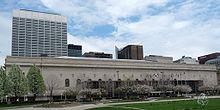- Public Auditorium
-
 Public Auditorium faces Mall B.
Public Auditorium faces Mall B.
Public Auditorium (sometimes called Public Hall) is located in the central business district of downtown Cleveland, Ohio. Since it was opened in 1922, it has served as a concert hall, sports arena and convention center. Although it was planned and funded prior to World War I, construction did not begin until 1920. Designed by city architect J. Harold McDowell and Frank Walker of Walker and Weeks in a neoclassical style matching the other Group Plan buildings, it was the largest of its kind when opened, seating 11,500.
The auditorium cornerstone was laid on Oct. 20, 1920, and the completed building was dedicated on April 15, 1922. Smith & Oby was one local company involved in the project, at the time the largest convention hall in the United States. In 1927, the Music Hall was added at the south end of the auditorium. The main arena floor is 300 ft. long, 215 ft. wide, 80 ft. high. No columns were used in its construction. The main stage is 140 ft. by 60 ft., with a 72- by 42-ft. proscenium arch. The stage is set between the main hall and the music hall and is shared by both halls using a curtain system. A key attraction was a spectacular pipe organ, the largest ever built at one time by E.M. Skinner with 10,010 pipes and 150 direct speaking stops.The seating capacity of the main auditorium, including the main floor and the U-shaped balcony, was more than 11,500. The Music Hall seated 2,800, the ballroom 1,500, the north exhibition hall 1,500, the Little Theatre 600 and other halls from six to 500. The basement Exhibition Hall provided more than 28,500 square feet of exhibit space.
In 1964, construction began on a new underground convention center, which opened on August 28 of that year. The Convention Center provided 26 meeting rooms, each holding from 50 to 10,000 people, and 424,230 sf of exhibit space. A modern glass and metal entrance and lobby area serving both convention center and auditorium were added on the Mall side of the Beaux Arts exterior. The architects were Outcalt, Guenther, Rode and Bonebrake. The cost was $17.5 million, including $1 million for improvements to the Mall Plaza.
In 2010 the underground convention center was demolished and construction began on a new $465 million convention center and Public Auditorium received a 3.9 million renovation and restoration project.
Public Auditorium has hosted many notable events, including the 1924 and 1936 Republican National Conventions, General Eisenhower's address on Sept. 23, 1952 to 15,000 supporters immediately after Richard Nixon's successful Fund Speech, and the 1993 Cleveland Orchestra 75th anniversary concert. Public Auditorium also was the site for many rock music acts throughout its history, serving as a venue for performers such as The Beatles, Madonna, Queen & R.E.M., when they performed at smaller facilities earlier in their careers. From 1981 to 1989 it was occasionally used as a home court for the Cleveland State Vikings Men's Basketball teams. Its use as a concert venue declined sharply after the completion of the CSU Convocation Center at Cleveland State University in 1991. In 2008 all seats were replaced in the balcony and in April 2009, it hosted the annual Rock and Roll Hall of Fame induction ceremonies. On April 14, 2012 the facility will once again be home to the induction ceremonies. [1]
References
- ^ "Busy time for Rock Hall". The Plain Dealer. 2008-08-14. http://www.cleveland.com/entertainment/plaindealer/index.ssf?/base/entertainment-1/1218702612151340.xml&coll=2. Retrieved 2008-08-15.
External links
- Cleveland Convention Center
- Positively Cleveland Meetings and Conventions
- Cleveland-Cuyahoga County Convention Facilities Authority
- Cleveland Public Auditorium and E.M. Skinner Organ photos
Coordinates: 41°30′12″N 81°41′34″W / 41.50333°N 81.69278°W
Categories:- Buildings and structures in Cleveland, Ohio
- Convention centers in Ohio
- Music venues in Ohio
- Sports venues in Cleveland, Ohio
- College basketball venues in the United States
- Visitor attractions in Cleveland, Ohio
- Ohio building and structure stubs
Wikimedia Foundation. 2010.

